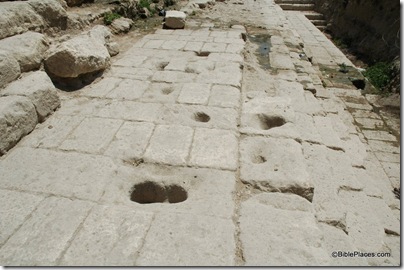If you have visited the Pool of Siloam since it was first discovered in the summer of 2004, you may have noticed some strange holes in otherwise beautiful paving stones running along the pool’s edge.
Sometimes holes were made in pavement for door sockets, but that hardly seems likely here given their placement. In theaters, holes which held poles for the fabric roof are sometimes found in the seating area. Given the suggestion that the Pool of Siloam served as a ritual bath (miqveh) in the 1st century, one could conceive of a need for curtains for protecting privacy. But this doesn’t seem to fit the configuration of the holes at the site.
Over on his blog, Tom Powers has advanced a new idea. I think it’s the best suggestion I’ve heard so far, but I’m not sure that I’m convinced yet. If you have any ideas or have heard other suggestions, chime in on the comments there.

10 thoughts on “Mysterious Holes at Pool of Siloam”
Could these holes be scars left over from attempts at drilling for water? Has it been considered that in the recent past, efforts may have been made to drill or dig wells directly over this site, while the area was covered with earth? Doubtless there were those through the years who knew that there was water at or near this buried location and may have attempted to drill or dig down to it. What say ye?
Not a bad idea. I'm still pushing this option:
http://2.bp.blogspot.com/_MhujxDSX9xI/TAKFTfgMo6I/AAAAAAAAALU/IPWP2gSLfNk/s1600/Siloam+Pool+holes+Dr+Pepper.jpg
Link not found, Al. Please check & repost.
Dani – that sounds reasonable, though I wonder how much work people would have exerted in digging with water flowing in the pool nearby. I would think that the archaeologists would be able to assess your suggestion from their study of the material they excavated from inside the holes.
G.M. – the link works for me. Here's a shorter link:
http://tinyurl.com/2bexhvd
Ah! Very good! When you visit the page for this full article ("Mysterious Holes"), the link spans across the article column into the About Me column to the right; however, when you visit the Leave Your Comment page (I'm on right now), the right column truncates the link at "TAKFTfgMo6I". Mystery solved!
Todd … As for the fact that there was and is the other pool nearby, totally agree that it is very close to this location. My hypothesis harkens back to a very early, post-70AD destruction time frame, perhaps a Byzantine era home or farm or some such, that attempted doing a well, unaware of the buried flagstone steps under the earth, and stopping when they reached what they thought was stubborn bedrock. Certainly, giving those holes a detailed [hands and knees] evaluation could indicate drill/dig abrasion that can't be seen otherwise from your photo. Have the archaeologists on this dig supplied an explanation?
Dani – I haven't heard of any explanation from the archaeologists.
as someone who's worked with stone before (marble, granite, limestone, etc. etc.), i can tell you that very often you see little flaws in the stone, maybe a more porous spot or something. indoors you don't have to worry about this. outdoors is a different story. water and moisture get in such porous areas (especially with, say, a "pool" next to it)and, over time, change of temperature and other factors cause them to erode. the stones in the pic were laid quite a while back, right? it's reasonable to think, then, that the holes are natural. they were probably porous areas on the stone that weather and moisture have eroded down to non- or less-porous areas.
just a guess, of course. they look too shallow to be functional, especially if a pivot for an upright gate-bar is ruled out.
They look to me like the wear from water pouring in. Is there any indication that the inflow of water might have caused this? Perhaps some decorative fountain action going on other than the practical conduit?
Nothing like a dumb joke delivered poorly. Try this:
http://tinyurl.com/2bexhvd